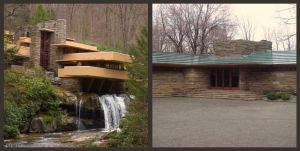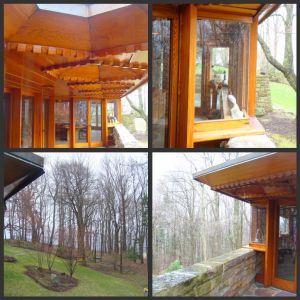My fiancé and I took a day and a half trip up to Western Pennsylvania to stay at Nemacolin Resort and visit Frank Lloyd Wright’s FallingWater and Kentuck Knob. Nemacolin was an interesting place: a mishmash of a little bit of everything: a world-class spa (which we enjoyed!), several different places to stay (A ‘château’, a ‘lodge’, and a 5 star resort: Falling Rock, modeled after some of Wright’s design elements’). It basically felt like an extremely rich person’s playground, except that for a fee, everyone else can play on it too! This means two golf courses, ski slope, cross country skiing, snow tubing, pools, tennis, a shooting academy, a zoo, even a Hummer off roading course (yay?).
My post isn’t about Nemacolin, because while it was fun, it was too confusing to be a ‘cheery observation’.
I instead choose to write a bit about Wright’s Falling Water and Kentuck Knob homes. Recently re-opened for the season, they were both stunning for different reasons.

Falling Water was a weekend home commissioned by the Kaufmann family (owner of the Kaufmann department store) at a time when Frank Lloyd Wright had few commissions: it was like a fresh start to a slightly stale career (at that stage) and he truly took a risk and went all out. The Kaufmanns had wanted a weekend home with a view of the waterfall. Frank gave them a home on TOP of the waterfall. Finished in 1937, Falling Water is a home that fits with nature. Whatever is happening on the outside is felt in the home—there is really no barrier to the outside world. The house is designed for clear views of the water and of the trees; if one wants to see the sky, they have to go outside. This visual effect makes being inside disorienting.

The home starts with a huge main living space with wall-to-wall windows and stairs down to the river and the first of many decks. The living quarters were designed to be more separate—each room’s main function is to look at nature and each room has an outdoor ‘deck’ bigger than the room itself. The ceilings in these rooms are low, designed to draw your eye out. The use of space is spectacular: small bathrooms tucked in nooks, bookshelves and built in desks. Wright constructed the home from all local materials–when I think about all of the cement in the building and the lack of modern cement mixers, I am baffled! Wright took a risk and created a one-of-a kind home, a home that is a National Historic Landmark and is on the list to become a World Heritage site.
Kentuck Knob was built about 20 years after Falling Water and is still a private residence. Originally built for the Hagan family, the house is now owned by Lord Palumbo. The house has unadulterated views into the surroundings woods and valleys. The house is centered around a hexagon shaped kitchen, with small hallways leading to the living quarters and the huge main living space. The ceilings are taller than Falling Water and the inside feels a bit like the inside of a yacht. In my opinion, the most stunning aspect of Kentuck Knob is the deck that lines the entire back of the house: the ceilings skylights are shaped in octagons allowing interesting patterns of light to come in; the deck allows for stunning views.

Both homes are harmonious with nature and quite different from your ‘typical’ American home built today OR in that time period. While Falling Water is anything but typical, Kentuck Knob was built as a full time residence and was never meant to be overly extravagant. When one is in either home, one feels a sense of peace, calm, and acceptance. The homes force you to be a part of nature; this is so unlike the majority of my life, be it in my office or apartment building, where it’s easy to have no idea what the outside world is like! The interiors of Wright’s home are made from natural ingredients with a focus on need, not want. Wright did not want excess closet space or storage space. I admire this style of architecture and the focus on harmonious living with nature. Falling Water was literally built on top of a waterfall; Kentuck Knob was built into the side of the hill: a peaceful collaboration.